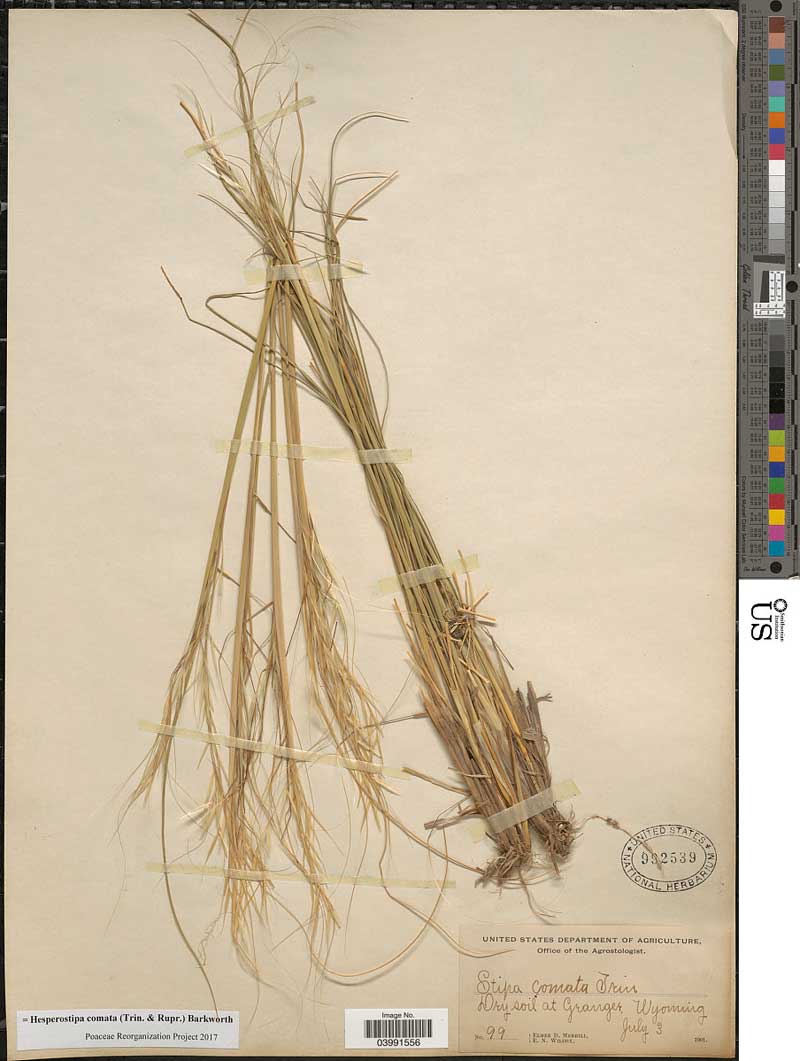
Classification System: APG IV
Superregnum: Eukaryota
Regnum: Plantae
Cladus: Angiosperms
Cladus: Monocots
Cladus: Commelinids
Ordo: Poales
Familia: Poaceae
Subfamilia: Pooideae
Tribus: Stipeae
Genus: Hesperostipa
Species: Hesperostipa comata
Subspecies: H. c. subsp. comata – H. c. subsp. intermedia
Name
Hesperostipa comata (Trin. & Rupr.) Barkworth
References
Phytologia; Designed to Expedite Botanical Publication. New York 74:16. 1993
USDA, ARS, Germplasm Resources Information Network. Hesperostipa comata in the Germplasm Resources Information Network (GRIN), U.S. Department of Agriculture Agricultural Research Service. Accessed: 07-Oct-06.
Hesperostipa comata, commonly known as needle-and-thread grass, is a species of grass native to North America, especially the western third. It has a wide distribution spanning from northern Canada to Mexico.[1]
Contents
1 Description
2 Habitat
3 Cultural
4 References
5 External links
Description
Hesperostipa comata is a perennial bunchgrass producing erect, unbranched stems to about 1 m (3 ft 3 in) in maximum height. The narrow inflorescence is up to 28 cm (11 in) long in taller plants, with the mature spikelet bearing a spiraling, hairy, spear-shaped awn[2] up to 19 cm (7+1⁄2 in) in length.
The seeds of this grass have hygroscopic extensions that bend with changes in humidity, enabling them to disperse over the ground.[1] Each seed has an awn that twists several turns when the seed is released. Increased moisture causes it to untwist, and, upon drying, to twist again, thus the seed is drilled into the ground.
Habitat
This is a grass of many habitat types, from grassland to pine forest. Young shoots provide a favored food source for black-tailed prairie dogs and black-tailed jackrabbits, and the grass is a good early spring graze for livestock before it develops its long, sharp awn.
Cultural
This species was described by the explorers during the Lewis and Clark Expedition.
Needle and thread grass is the provincial grass of the prairie province of Saskatchewan.
This species is popular among children because of the seed's ability to be thrown and stick to clothing.
References
Zlatnik, Elena (1999). "Hesperostipa comata". Fire Effects Information System (FEIS). US Department of Agriculture (USDA), Forest Service (USFS), Rocky Mountain Research Station, Fire Sciences Laboratory.
Taylor, Ronald J. (1994) [1992]. Sagebrush Country: A Wildflower Sanctuary (rev. ed.). Missoula, MT: Mountain Press Pub. Co. p. 70. ISBN 0-87842-280-3. OCLC 25708726.
Retrieved from "http://en.wikipedia.org/"
All text is available under the terms of the GNU Free Documentation License

